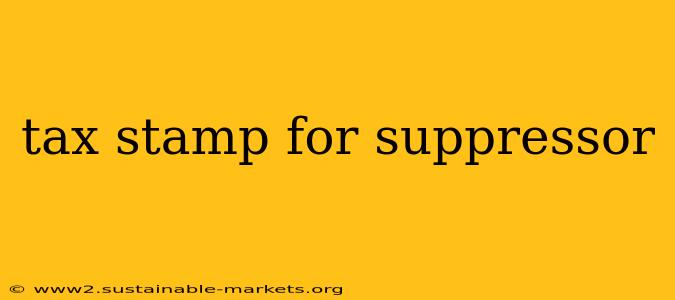Purchasing a suppressor, also known as a silencer, involves more than just selecting a model and adding it to your cart. A crucial step often overlooked by new firearm owners is the process of obtaining a tax stamp. This guide will walk you through the complexities of the National Firearms Act (NFA) and provide you with the information you need to successfully navigate the tax stamp application process for your suppressor.
Understanding the National Firearms Act (NFA) and Suppressors
The NFA, enacted in 1934, regulates certain firearms and firearm accessories considered "destructive devices," including suppressors. This legislation requires individuals to obtain a tax stamp from the Bureau of Alcohol, Tobacco, Firearms and Explosives (ATF) before legally possessing these items. Failing to comply can result in significant legal consequences. The tax stamp itself isn't just a simple piece of paper; it's a legal authorization proving your compliance with the NFA and your right to own the suppressor.
Key Considerations Before You Begin
Before you even think about applying for a tax stamp, there are several crucial factors to consider:
- State Laws: While federal law requires the tax stamp, your state might have additional restrictions or regulations regarding suppressor ownership. Research your state's specific laws before proceeding.
- Legal Counsel: If you have any doubts or uncertainties about the process, consulting a lawyer specializing in firearms law is highly recommended.
- Time Commitment: The entire process can take several months, sometimes even longer. Be prepared for a prolonged waiting period.
The Suppressor Tax Stamp Application Process: A Step-by-Step Guide
The application process for a suppressor tax stamp is primarily handled through ATF Form 4. Here’s a breakdown of the steps involved:
-
Complete ATF Form 4: This form requires detailed personal information, including fingerprints and photographs. Accuracy is paramount; any errors can significantly delay the process.
-
Certified Fingerprint Cards: You will need to get your fingerprints taken by a certified agency authorized to handle these submissions. The ATF website provides a list of approved locations.
-
Passport-Style Photos: Provide clear, recent passport-style photographs according to the ATF's specifications.
-
Payment of the Tax: A tax of $200 is currently required for the tax stamp. Make sure to pay using the correct method as specified by the ATF.
-
Submit the Application: Once everything is completed, mail the application package to the correct ATF address, ensuring it is sent via a traceable method. Keep a copy of everything for your records.
-
Waiting Period: This is where patience is key. The ATF processing time can vary significantly, and it often takes several months to receive your approval. You'll receive notification once your application is approved.
-
Receiving Your Tax Stamp: Upon approval, you'll receive your tax stamp. This document officially authorizes your possession of the suppressor. It's essential to keep this document safe and readily available.
Tips for a Smooth Application Process
- Accuracy is Key: Double-check all information on your Form 4 for accuracy to avoid delays.
- Keep Copies: Retain copies of every document you submit to the ATF.
- Track Your Application: The ATF website sometimes provides online tracking tools to monitor the status of your application.
- Patience is a Virtue: The process can be lengthy. Don't get discouraged.
Conclusion
Obtaining a tax stamp for your suppressor is a necessary legal step. By understanding the process and following these guidelines, you can navigate the NFA requirements successfully and enjoy your suppressor responsibly. Remember to always comply with both federal and state laws. This information is for guidance only, and you should always consult with legal professionals for specific advice relating to firearms regulations.

